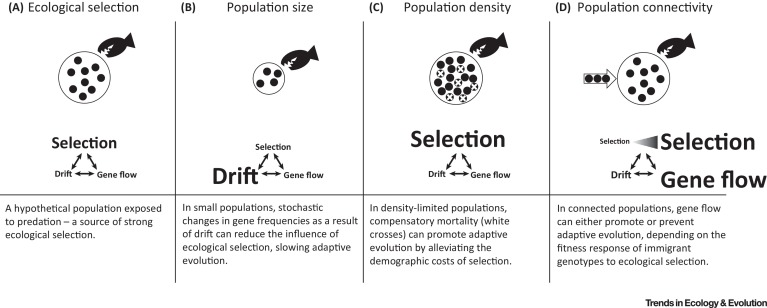今天读的也是发表在trends in ecology and evolution 上的综述,具有教科书的性质。
http://www.cell.com/trends/ecology-evolution/fulltext/S0169-5347(16)30235-X
摘要:
The interplay of ecology and evolution has been a rich area of research for decades. A surge of interest in this area was catalyzed by the observation that evolution by natural selection can operate at the same contemporary timescales as ecological dynamics. Specifically, recent eco-evolutionary research focuses on how rapid adaptation influences ecology, and vice versa.
Evolution by non-adaptive forces also occurs quickly, with ecological consequences, but understanding the full scope of ecology–evolution (eco–evo) interactions requires explicitly addressing population-level processes – genetic and demographic.
We show the strong ecological effects of non-adaptive evolutionary forces and, more broadly, the value of population-level research for gaining a mechanistic understanding of eco–evo interactions. The breadth of eco-evolutionary research should expand to incorporate the breadth of evolution itself.
上面读得不懂,看它的trends,类似于通俗版的摘要:
Eco–evo interactions are mediated by population genetics and demography, but current research often fails to consider this population context.
Population genetics theory provides a framework for understanding the full scope of eco–evo interactions, including the effects of adaptive and non-adaptive forces.
Our review shows the ecological effects of non-adaptive evolution and the mechanistic insight gained in population-level research on eco–evo interactions. Population-based approaches integrating genetic and demographic information will advance general understanding of the scope, strength, and scale of eco–evo interactions.

We define mean fitness according to population genetics theory as the sum of the fitnesses of genotypes in a population weighted by their proportions , thus representing the population-level effects of local adaptation.

Population Parameters Affect the Balance of Adaptive and Non-Adaptive Evolutionary Forces. Illustration of the relative influence of different evolutionary forces in a population exposed to predation (A) as a function of population size (B), population density (C), and population connectivity (D). Text size represents variation in the relative influence of each evolutionary force.

Three Types of Genetic Connectivity. Expected values of FST with the island model of migration in which N is the local effective population size (Ne) . Arrows indicate the FST values for the three types of genetic connectivity – the degree to which gene flow affects evolutionary processes within populations. Under adaptive connectivity, gene flow is sufficient to spread advantageous alleles. Under inbreeding connectivity, gene flow is sufficient to avoid the harmful effects of local inbreeding. Under drift connectivity, gene flow is sufficient to maintain similar allele frequencies among populations. Redrawn from Lowe and Allendorf.
Glossary
Compensatory mortalitywhen one source of mortality largely replaces another source of mortality, resulting in little or no change in population dynamics.Density dependencewhen population growth or specific demographic rates (e.g., mortality, fecundity) are regulated by the density of the population.Dispersalpermanent movement away from an origin and long-term settlement at a new location.Disruptive selectionnatural selection that favors extreme values of a trait over intermediate values, also known as diversifying selection.Eco-evolutionary dynamicsinterplay between ecological and evolutionary dynamics in real time (i.e., relatively instantaneously).Effective population size (Ne)the size of an ideal population that would experience the same amount of genetic drift as the observed population.Fixation index (FST)a measure of population subdivision that indicates the proportion of heterozygosity found between populations relative to the amount within populations.Gene flowmovement of genes from one population to another. In population genetics theory, gene flow is represented by migration rate (m) – the proportion of individuals in a focal population that are immigrants.Genetic driftchange in gene frequencies over time owing to random differences in the survival and fecundity of individuals, as well as to binomial sampling of alleles during meiosis.Genetic rescueincrease in population growth of small populations following immigration, resulting from the reduction of genetic load caused by inbreeding depression.Hard selectionnatural selection that removes from the population individuals whose phenotype does not attain a particular threshold, independently of population density or genotype/phenotype frequency. Hard selection can result in additional mortality, and can therefore depress population size.Selection coefficienta measure of the reduction in the relative fitness of a given genotype. The selection coefficient takes a value between zero (no reduction in fitness) and one (fitness is zero).Soft selectionnatural selection that eliminates individuals that do not achieve a particular relative value of a given trait. Under soft selection, selective deaths are substituted for non-selective mortality, and it therefore has little effect on population size.